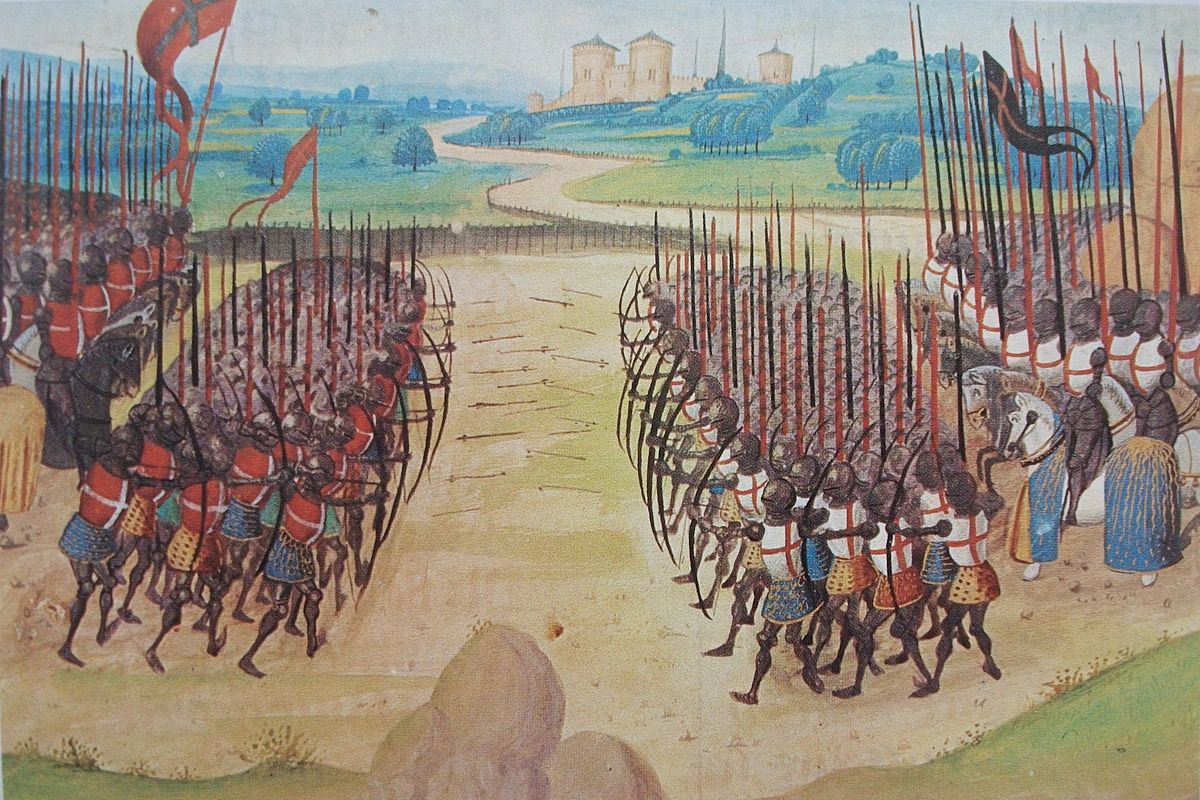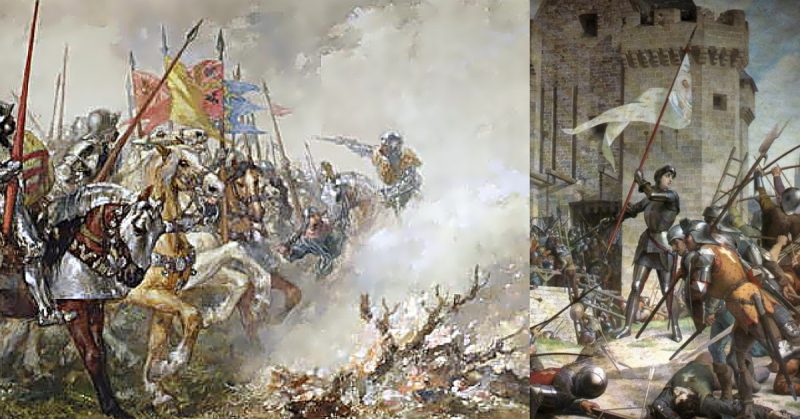leaders and commandants at the time of Hundred Years War
The Hundred Years War was one of the most protracted wars of the Middle Ages. For over a century, the French and English monarchies battled for control of the French nation and the territories of northern and western France. Success in this on-going conflict required strong leadership.
https://www.warhistoryonline.com
An interesting article about the commanders and command hierarchy during the Hundred Years War.
The Hundred Years war, men and weaponry
The Hundred Years War is a conflict that fascinates on both sides of the Channel, it is spread over more hundred years but this war is cut off for many years without fight. It saw several English and French sovereigns tearing themselves up for a question of succession to the crown of France. This question, however, hides a set of deeper reasons, particularly of sovereignty. However, it is not a question of speaking only of events, politics or diplomacy during these years of war. The objective is to take an interest in the men who fought at that time from the king to the simple man-at-arms or arrow. To learn a little more about who they are, where they come from, their method of combat, the military hierarchy, the chain of command, their equipment and so on.
Documentary: Agincourt, myths and misconceptions
The wallace collection
Agincourt Myth and misconceptions
In august of 1415 King Henry V of England set sail from Southampton at the head of a huge army with the intention of pressing the old English claim to the throne of France. After a lengthy siege at the port city of Harfleur, Henry moved with his army cross country, through northern France probably heading for Calais. And he was also probably looking for a fight. And a fight is exactly what he got at Agincourt. The battle of Agincourt is one of the most famous events in British history, but it’s also one of the most misunderstood. History is not necessarly about what happened it’s often about what someone wants you to think happened or its about how we wish it had been. Over the last 600 years, the story of Agincourt has become intertwined with concepts of English identity and notions of Anglo-French rivalry. We imagine it as a battle solely between low-born English archers against a vastly superior number of aristocratic French knights and that’s an enormously appealing image because it’s a model for class war. And right at the centre of this idea is of course the image of the English longbow which is imagined to be some kind of super weapon. We tend to create stories that appeal to us and then a habit of imposing those stories on the past. When Shakespeare wrote his famous play Henry V, he did so at a time when English armies had again been fighting in France. And then during the second World War, when Winston Chruchill commissioned Laurence Olivier to make a film of Henry V, he did so again for the same reasons to boost morale in advance of the Allied invasion of France. So now when we look back towards the Agincourt period, we do so through layers of later myth and misconception. How then we can learn more about what actually happened ? Of course, there are the written sources in libraries and archives but beyound that, we can also look at objects for exemple weapons and armour that were really used at the time, looking at objects brings use into a very immediate physical contact with the past central to the myth of Agincourt, is the idea that armour is incredibly heavy and that leads to strange nonsensical ideas like the need for the knights to be winched onto their horses with cranes, in reality, armoured knights mounted their horses in the usual way, and the weren’t nearly as encumbered by their armour as we tend of imagine. The fallacy of incredibly heavy armour has had a very powerful influence on traditional interpretations of the battle we often take the apparent fact that the Franch wore quite a lot of heavy armour as evidence that they were somehow out of touch when we look at real armour we quickly reallise that our story of this battle has to change. This is a fine mail shirt dating from the late fourteenth or early fifteenth century. It is made up of thousands of interlocking iron links each one of which has been carefully riveted closed, providing excellent protection against cuts from sharp laded weapons, and it could even stop some thrusting and stabbing attacks. It was also incredibly flexible, it’s a metal fabric which achieved a good balance of protection and mobility and protected areas of the body which the plates couldn’t so worn under plate armour at Agincourt, mail like this helped to proof the French armour against the thousands of arrows loosed by the English. This is a very rare example of a type of closely fitted helmet called the bascinet. Thousans of helmets like this one were almost certainly worn at Agincourt. It gave good protection to the vulnerable area around the throat where mobility was really important. The pointed visor of this helmet was designed to deflect arrows and other weapons striking the wearer directily in the face. Another classic element in the myth of Agincourt has the English archers shooting high up into the air at long range, so that they drop the arrows down their enemies heads from above. However, eyewitness accounts of the battle tell us that the English shooting was so thick ththat the French feared that the sights and the sides of their visors would be pierced, not the tops of their heads. This strongly built helmet was only vulnerable in those small areas, the sights or vision slots and breaths, the ventilations holes on the sides of the visor. A key of the true reality of the battle therefore is found by interpreting he written accounts, alongside the surviving objects. And those two things, in this case looked at together, tell us that the archers in fact were shooting straight on, at close range and the French were getting hit straight in the face although armour surviving in museum collctions has a lot to tell us to build up a more complete picture of the armoured warrior at the time of Agincourt, we have to look elsewhere, not in museums but in churches. Medieval funery effigies are an important source of evidence in the study of armour. The best examples were carved with fantastic skill and display a starling level of technical detail. This beautiful alabaster example belongs to Sir Edmund Thorpe, one of Henry V’s battle-hardened captains. Here we can see every rivet, every strap, every tiny detail cut with phenonmenal skill into the alabaster. The armour was the man, so it was that on his effigy, all of the technical details should be right. The battle of Agincourt is just one of an almost infinite number of examples of how we can become very confused and mixed up about what really happened in the past. And looking at objects is a powerful It is a museum in London, its collections are the legacy of Sir Richard Wallace died in 1890. Among its collections of weapons and old armor.way of complmenting the written sources they give you a tangible, physical anchor for better informed interpretation. They give you a tangible, physical anchor for better informed interpretation, so thats’s why it’s rally important to look at things in museums like the Wallace Collection.
What is the Wallace Collection? It is a museum in London, its collections are the legacy of Sir Richard Wallace died in 1890. Among its collections, weapons and old armor.
Longbow, weapon of victory
While bows have been used for hunting and warfare for thousands of years, few achieved the fame of the English Longbow. The weapon first rose to prominence when it was deployed by the Welsh during the Norman English invasions of Wales. Impressed by its range and accuracy, the English adopted it and began conscripting Welsh archers into military service.
https://www.thoughtco.com
Hundred Years Wars (1337-1453)
Historical tradition dates the Hundred Years War between England and France as running from 1337 to 1453. In 1337, Edward III had responded to the confiscation of his duchy of Aquitaine by King Philip VI of France by challenging Philip's right to the French throne, while in 1453 the English had lost the last of their once wide territories in France, after the defeat of John Talbot's Anglo-Gascon army at Castillon, near Bordeaux.
http://www.bbc.co.uk
This article is written by Maurice Keen, a great British medievalist, and it is published on the BBC website. This article is short but very complete and interesting, the article allows to see in broad lines the history of this war, in particular the fifth part on the armies, their composition and armament.
Effigies, tombs, funeral slabs of princes and nobles
Effigies of the nobles are interesting to discover the noble fighters of the end of the Middle. If the composition of medieval armies are different between France and England and evolve, the nobility playes an important role, the nobility is defined by the profession of arms. The tombs are also very interesting to show the nobles in arms, to see the variety and evolution of the armament over time but also the differences between the nobles who is not a homogeneous social order. Under the term of nobility hides a variety of profiles, princes, counts, local lords, a multitude of little nobles.
Illustration: Knight, 1400-1425, Toulouse Museum.
Armor evolutions at the end of the Middle Ages
This video presents several interests for our problematic. First, it shows us the evolution of the defensive weaponry of the men-at-arms in the Middle Ages, in particular the changes in the types of protections but also in the techniques of manufacture. The other interest of this video is to talk about mercenaries and foreign contingents. If this war opposed the Kingdom of France to the Kingdom of England, the diplomatic alliances involved other principalities. The need for fighters has also called men across the British Isles and continental Europe to come on batllefields.







/battle-of-crecy-large-56a61bbf3df78cf7728b6144.jpg)

